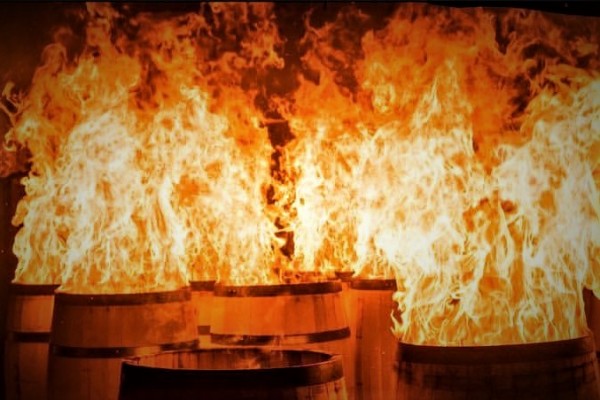By Caitlin Richards
There are many factors that determine the flavor of a whiskey: choice of grain and how it’s malted, through choice of barrel and barrel storage, all have a hand in what ends up in the bottle. These factors are all magnified when it comes to small batch, craft distilling. A distiller can start with the same ingredients each time and end up with different results. A lot of that has to do with the type of barrel and length of time and conditions of aging. Colkegan Apple Brandy Cask Finished Single Malt starts off as Colkegan Single Malt, aging in both new and used 53 gallon oak barrels for a minimum of two years in Santa Fe Spirits’ climate controlled barrel aging rooms. As distillers Steffany Landers and Mike Kelley taste barrels to make a blend of Colkegan they tag some barrels that will become Apple Brandy Cask Finished Colkegan. These are usually older barrels (four to five years) in which the flavor profile stands out too prominently to fit in a blend of Colkegan, perhaps oakier or smokier than the rest of the barrels in the blend.
When the Santa Fe Apple Brandy has finished aging and has been dumped from barrel to tank in preparation for bottling, the tagged Colkegan barrels are poured into the still wet Apple Brandy barrels. As Santa Fe Spirits uses 25 gallon barrels for its Apple Brandy and 53 gallon barrels for Colkegan, one barrel of Colkegan will go into two separate used Apple Brandy barrels, therefore changing the end flavor of even one barrel of Colkegan after it spends a year aging in its new barrels. The result? “They’re all original,” says Steffany of the Apple Brandy Cask Finished Colkegan batches.
With so much depending on the barrel it’s important to understand how a barrel is made. Kelvin Cooperage has been making wine and bourbon barrels in Louisville since 1991, when the company relocated from Scotland where they started out repairing used bourbon barrels for scotch houses. According to Britney Wimsatt, Kelvin specializes in making bourbon barrels for the craft spirits industry: “it’s our niche, and it sets us apart from larger, mass produced, barrels.” She says the craftsmanship of Kelvin’s barrels is akin to the craft spirits that go into the barrels, all hand-produced by people doing the work because they have a passion for what they do.
All of Kelvin’s barrels are handmade. Kelvin purchases staves from several local stave mills, which they then sand, plane and joint before the staves are ready for use. Once the barrels are assembled they are toasted and then charred over natural oak burning fires. Unlike most cooperages, who only toast wine barrels, Kelvin toasts all of its barrels. What’s the difference between toast and char? “Think about toasting a marshmallow,” Britney says, if you hold it further away from the fire it gets a nice, brown, toasty outside, but it’s not blackened. Char leaves the wood blackened and, well, charred. Britney further explains that toast is where flavor comes from whereas char is what affects color. Kelvin offers char levels of one to four, with four being the heaviest, resulting in the darkest spirits.
The charring at Kelvin is what they are most proud of; barrels are charred in batches of nine outside over natural oak fires, and done entirely by sight and smell. While all coopering is a skilled craft, the making of “tight” barrels (which hold liquids, as opposed to “slack” barrels which hold dry goods) is the most skilled, and charring by sight and smell alone over open fires is very specialized and precise. On a good day Kelvin produces 450 barrels.
In his 1910 book Cooperage, A Treatise on Modern Shop Practice and Methods; From the Tree to the Finished Article, J. B. Wagner (not one to be succinct) waxes on for several pages about “The Waste Problem” in manufacturing cooperage stock, saying at one point that “much of this lack of utilization cannot very well be prevented, yet there are possibilities of much more economy than is generally practiced.” Kelvin uses any oak waste or by-product for its fires, thereby having little wood that actually goes to waste.
In 2013, when many craft distilleries were starting out, there was a barrel shortage panic. This wasn’t, as many thought, because there was a lack of oak trees, but rather because many loggers went on strike because demand for American Oak was high and they weren’t seeing the results of the boom in their pay packets. Kelvin remained unaffected by this due to close relationships with several local mills. Kelvin is also involved in the White Oak Sustainability Project to ensure future availability of White Oak, as well as mindful lumber practices.
Bourbon barrels differ from wine barrels in size, (wine barrels usually being 59 or 60 gallons), the addition of char, and steel hoops rather than galvanized. Wine barrels use galvanized hoops to eliminate rust, but that’s largely for aesthetic reasons.
The shape of the barrel hasn’t changed in thousands of years, and while there are now factories that mass produce barrels, the art of hand making barrels also remains largely unchanged. The origin of the barrel isn’t known. According to Wagner “more than eighteen hundred years ago Pliny, an original investigator … endeavored to trace to its origin an industry that was even then ancient and honorable.” Britney adds that until the mid nineteenth century it was common for ships to have a cooper on board – they would spend the outbound voyage making barrels in which to put goods on the return journey.
The life span of a barrel varies greatly depending on its use. Bourbon is required to be aged in new barrels. At Santa Fe Spirits new barrels are generally used two or three times, while the used bourbon barrels are used once. The Apple Brandy barrels will be used twice, then repurposed for the Apple Brandy Cask Finished Colkegan or experimenting with other projects. Many barrels that Santa Fe Spirits can no longer used are purchased by local breweries and go on to have beer aged in them. Kelvin will sometimes take used barrels and rejuvenate them with fresh char, but the cost to ship barrels doesn’t make this a viable option for distilleries not near Louisville. Santa Fe Spirits also uses up spent barrels by making displays for stores who carry Colkegan, and have turned some into tables for their distillery tasting room. Many barrels that are no longer sound are sold to enterprising people who use them as planters, home bars, chairs, or who take them apart to use the staves in various projects. Britney says she has heard of some Canadian Whiskey in 60 to 80 year old barrels. However she has never heard of anyone using barrels to store monkeys.
So, what happens to Colkegan in a used Apple Brandy barrel? “It mellows and sweetens” says Steffany, “because there’s no smokiness in the Apple Brandy.” “More depth and body, smoother,” adds Mike. Santa Fe Spirits bottles all of its Colkegan Apple Brandy Cask Finished from single barrels, so each batch will have its own unique flavor. With the Apple Brandy Cask Finished “we like to maintain the differences,” explains Steffany. She suggests buying bottles from several different stores and the distillery in order to taste all the batches and see the differences for yourself. “They’re all good.”
Currently Santa Fe Spirits releases Colkegan Apple Brandy Cask Finished only once a year, in the fall.


